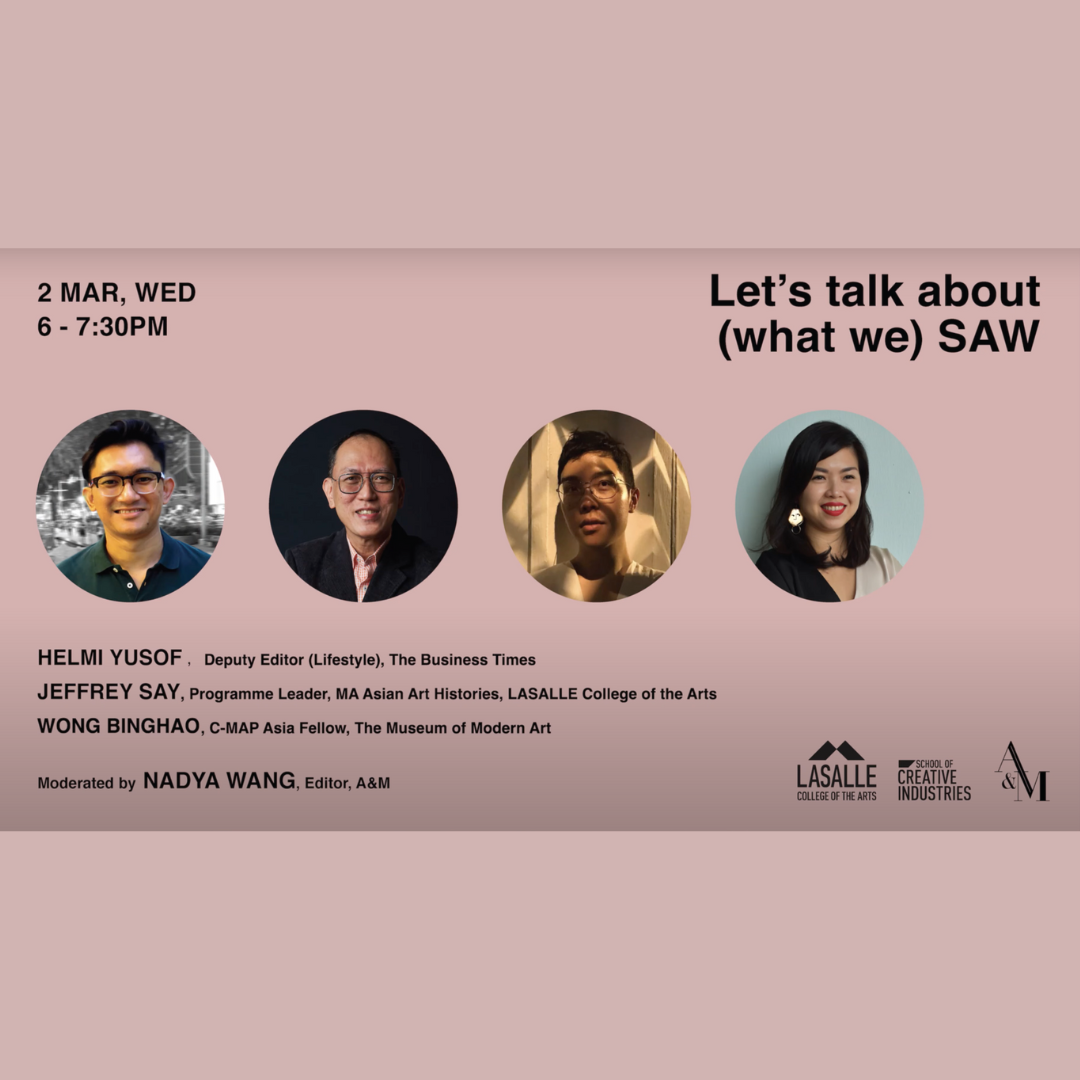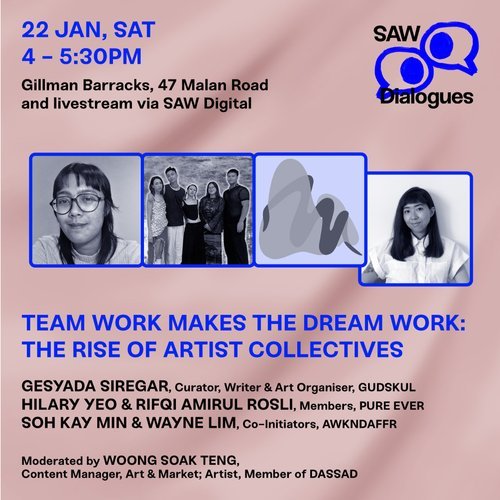A&M Salon 2: Art X Architecture
Living Memories with Guillaume Lévy-Lambert, Hidayah Amin, Joanna Lee, Teo Han Wue
By A&M
On 20 November 2021, we held A&M Salon 2 at the upper floor of shophouse at 63 Spottiswoode Park Road, in collaboration with Art Agenda for their exhibition ‘Surfaces of Time: Chua Ek Kay and Lee Lim’ on the lower floor, which featured the artists’ ink paintings and photographs respectively. Chua and Lim found beauty in the imperfect walls, calling attention to their gritty and mouldy surfaces.
Poster for A&M Salon 2.
For A&M Salon 2, we gathered with Guillaume Lévy-Lambert, Hidayah Amin, Joanna Lee and Teo Han Wue to talk about the intersection of art and architecture. Moderator Jefferson Jong, Director, Art Agenda began by quoting gallerist Marjorie Chu in the documentary ‘Being and Becoming Chua Ek Kay’, directed by Jin-Theng Craven, who said, “That’s not what he wants to paint – a perfect bird, a perfect rock, or a perfect tree… When he saw Chinatown, he saw the roughness of the building… they are about something that is very rough and as if it is rubbed in.” This spoke to the tactile and evocative works of both Chua and Lee as seen in the exhibition, and introduced the potential of artworks to further preserve the memories that buildings witness and possess.
Chua Ek Kay, ‘旧街景系列:麦肯芝路咖啡店 (A Coffee Shop At Mackenzie Road)’, 2001, ink and colour on rice paper, 95 x 86cm.
Lee Lim, ‘翠山逸趣 (Splendour of the Emerald Hill)’, 1980s, chromogenic print on paper, 58.5 x 48cm.
Taking their cue from this quote, the participants shared their experiences at the intersection of art and architecture. Han Wue recollected his interactions with both Chua and Lee and their interest in capturing the surfaces and spirit of shophouses in their works, and Joanna spoke about the book ‘Chua Ek Kay: Singapore Street Scenes, Evoking Memories’, which she edited, as well as her memories living in the Blair Road Conservation Area which includes Spottiswoode Park Road.
A&M Salon 2 at 63 Spottiswoode Park Road. From left to right: Jefferson Jong, Teo Han Wue, Hidayah Amin, Joanna Lee and Guillaume Lévy-Lambert.
@vphoen, ‘63 Spottiswoode Park Road’, 2021, polylactic acid polyester filament, 10 x 10cm, edition of 4.
There were two other residents of conservation areas among the participants. Guillaume spoke about his efforts to renovate his shophouse home with architect Sim Boon Yang on Spottiswoode Park Road, which won the Architectural Heritage Award in 2003, and the memories he continues to build living and working in the neighbourhood. And Hidayah Amin reminisced about growing up in her family home Gedung Kuning, or Yellow Mansion in the Kampong Gelam Conservation Area. This was acquired by the government under the Land Acquisition Act in 1999. She has been on a personal journey to preserve the memories of her childhood home and neighbourhood, and her book ‘Leluhur: Singapore’s Kampong Gelam’ won the NUS Singapore History Prize in 2021.
Images of Gedung Kuning where Hidayah grew up.
The discussion at A&M Salon 2 revealed urban conservation as a double-edged sword. On the one hand, it protects heritage sites from being torn down to make way for new developments. In this way, we are still able to experience over 6,500 conserved shophouses in Singapore, for instance. On the other hand, conservation may privilege the physical preservation of buildings over the social communities living in them. As an example, many people who grew up in Kampong Gelam were asked to move away when the area was conserved. Because there was little to no consultation with the residents who used to live in now-conserved areas, micro-histories are easily lost.
Mural by Alex Face at 63 Spottiswoode Park Road.
Mural by Yip Yew Chong on Everton Road.
The speakers spoke about how art has an important role to play in conserved neighbourhoods. In the Blair Plain Conservation area, Guillaume commissioned Thai artist Alex Face to create a mural on the back of 63 Spottiswoode Park Road. Honouring the area’s culturally diverse history, one character adorns a traditional Chinese blouse and the other is dressed in a nonya kebaya with flowers in her hair. Another mural in the area is ‘Provision Shop’ by local artist Yip Yew Chong, a commission from the owner of 8 Spottiswoode Park Road. The image reflects a scene from the 1970s and 1980s, depicting a store selling dried foods, kitchenware and snacks, a vespa, as well as a soya beancurd seller. Although these images may not be entirely true to life, they enliven the area with memories of the neighbourhood.
The audience was treated to a lively discussion that wove personal and collective memories together through the mediums of art and architecture. Audience member Teresa Alvarado says, “I loved to learn first hand from Hidayah Amin about what it was like growing up in a kampong.” She adds, “The event reaffirmed my own idea that a house is not just a pile of bricks but home; a living history that helps us to understand ourselves and the community we live in.” Another audience member Low Nguan Kiang reflects on how the ties in the community can just as easily break when there are changes in the physical neighbourhood.
The murals by Alex Face and Yip Yew Chong, the exhibition ‘Surface of Time’, the documentary ‘Being and Becoming Chua Ek-Kay’, the books ‘Chua Ek Kay: Singapore Street Scenes, Evoking Memories’ and ‘Leluhur: Singapore’s Kampong Gelam’ all help memories to live on and strengthen community ties. We are glad to have spent a Saturday afternoon finding connections between art and architecture through these individual projects, and look forward to the next A&M Salon to discover more that art has to offer than meets the eye.
We initially planned to make a recording of A&M Salon 2 available, but are alas unable to do so because of an unexpected technical error. Do follow @artandmarket on Instagram and Facebook or sign up for our fortnightly e-newsletter here for news of future events that you can attend in person or via livestream.
If you would like to purchase a copy of ‘Leluhur: Singapore’s Kampong Gelam’, publications on Chua Ek Kay and Lee Lim, the artwork by @vphoen featuring the shophouse and more, click here to browse A&M Marketplace. We ship worldwide.





















